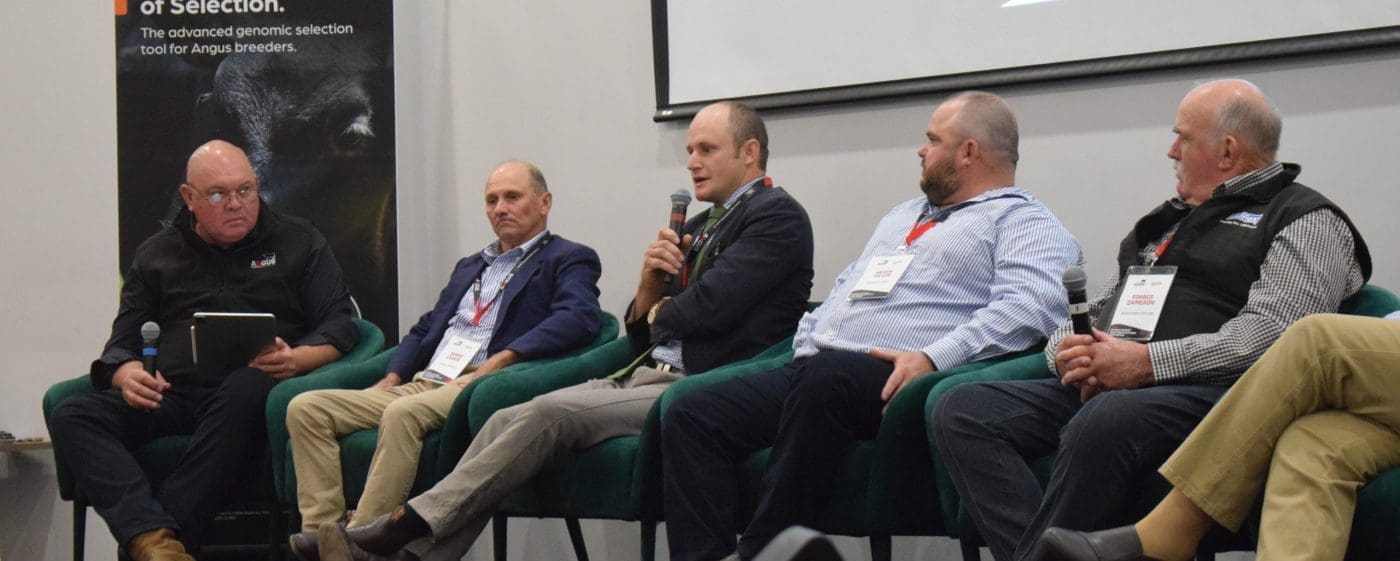
Angus Australia CEO Scott Wright interviewing a panel of producers including James Laurie, Nick Boshammer with the microphone, Heath Tiller and Forbes Cameron.
VERSATILITY was the centre of discussion at last week’s Angus Australia conference, with talk about improving genetic traits for Northern environments and capitalising on opportunities presented by growing “sustainability” markets.
During the Tamworth conference the breed society released its five-year plan titled “Angus for Every System”, which had a general focus on tailoring genetics for emerging markets, more efficient sharing and collection of data and developing people within the organisation and the wider breed.
The release of the plan was followed by a panel discussion with breeders from Australia and New Zealand – including Chris Metcalfe from Western Australia, Frank Archer from Tasmania, Noleen Branson from Victoria, Forbes Cameron from NZ, Heath Tiller from South Australia, James Laurie from New South Wales and Nick Boshammer from Queensland.
While many subjects were discussed in the session, capitalising on developing markets in Central and Northern Australia was one of the main topics.
Mr Metcalfe’s family Angus stud in Southern WA has been selling stock to the arid/semi-arid Southern Rangelands of WA. He said it was an incredibly harsh environment that required some specific traits.
“It is traditionally sheep, has a lot of saltbushes and poor-quality pastures and there are a lot of Shorthorn and Droughtmaster cross cattle,” he said.
“We have a client in the Goldfields region, he likes a specific type of animal with a bit more leg, good feet and can carry itself over the saltbush. He sells the calves into South Australia and gets paid a premium on coat-colour – so a slick coat animal is very important for him.
“A challenge for us is making sure those types of cattle do well in that environment.”
Research underway for EBV on coat-type
A question was raised by a member of the crowd about selecting for coat-type, for which Mr Tiller said he did through his own observations – he sells stock in an area from the Northern Pastoral Zone of South Australia to the Alice Springs area of Central Australia.
“My main market is heavily focused on animals with a fine and slick coat,” he said.
“Whenever I am looking at a bull sale catalogue or a semen catalogue, the first thing I am looking at is making sure it has that specific coat-type and then I work from there.”
Angus Australia’s general manager for genetic improvement Christian Duff said researchers were developing an Estimated Breeding Value on coat-type.
“We have almost 20,000 phenotypes coming in and we still need to test it for correlations with other traits before we make it a full EBV,” Mr Duff said.
“But it is there for selection, it works on a standard scoring system and mostly looks at coat length, with some other traits.”
Diversity in meat market markets
Mr Boshammer was another panel member who said his clients were looking for a fine and slick coat, with a lot of them being above the tick line of Qld. He said the next step for the breed was capturing new markets at the meat consumer-end.
“I keep relating to the shelf-product and providing more choice to the consumer is a great way to capture new markets,” he said.
“If we can keep making a product where consumers are willing to pay more, it will keep up the demand for Angus cattle and ultimately make things easier in the production chain.”
Based on the North Island of New Zealand, Mr Cameron agreed the next step was focusing on carcase traits and eating quality.
“With Angus, the focus always has to be on breeding and making sure the cows are always back in calf. But once we have that sorted out, the next step should be on carcase traits,” he said.
“We were at a feedlot the other day and the steers were dressing out to 54 to 60pc and I think we should be getting more feedback so we can find out which ones were closer to 60.
“In New Zealand, some of our grassfed steers are dressing out to 60pc and that is without grain – so maybe that is another step for Angus Australia.”
Potential with beef on dairy
Mr Cameron also spoke about the potential for the Angus breed to work with the dairy industry – a concept that was also brought up by McDonald’s meat procurement contractor FMG.
“The dairy industry in New Zealand does not want to kill bobby calves anymore and that is a huge opportunity for us,” he said.
“It is a good opportunity for dairy because they can use sexed semen for their replacement heifers and the rest can go to beef bulls. The beef industry in NZ is not very good with its calving rate and there is huge opportunity to improve on that by working with dairy.”
Mr Archer said the Tasmanian industry and his business were also looking at beef on dairy.
“I think there is a notion that dairy is a dirty word when it comes to beef production, but in reality I think it is a huge opportunity for Angus,” he said.
“One thing Angus has is really predictable data and outcomes and the dairy industry is driven by data – it can make some really powerful decisions through the data it collects. If the Angus breed doesn’t capitalise on this, than I don’t think the outcome is as good for the dairy industry.”
